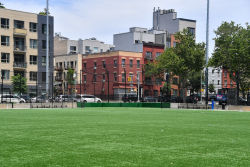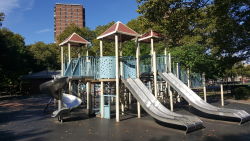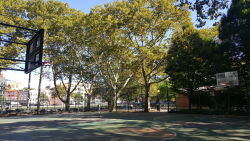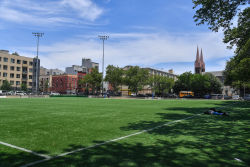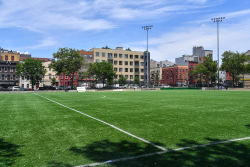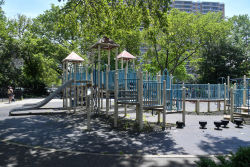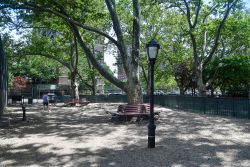Sternberg Park
Sternberg Park
What was here before?
In early 20th century, the block between Boerum, Leonard and Lorimer Streets and Montrose Avenue was described as one of the most congested in Brooklyn. In 1919, the block was occupied by a combination of commercial and residential buildings housing “187 families, 43 stores, 2 factories, 1 garage, 1 stable, and 1 candy store.” Over the course of the 20th century, the area surrounding the park underwent massive reconstruction, with the creation of the Lindsay Park Houses and the rebuilding of the adjacent George H. Lindsay School (P.S.250) in 1964.
How did this site become a park?
The City of New York acquired this property in 1919. Although the Board of Aldermen (predecessor to the City Council) approved the site for a park that year, it was not without some controversy due to the many occupants living on this particular block at the time. After much debate, the City Comptroller’s Office decided in 1924 that a playground was a much-needed addition to this densely-populated area, and the existing buildings were demolished although they were occupied.
Originally known as Williamsburg Park, in 1925 it was officially named Lindsay Park, in honor of George H. Lindsay (1837-1916), a congressman representing Williamsburg from 1901 to 1913. The original 1.84-acre park was expanded by local law in 1964 adding over two acres via the Urban Renewal Plan.
In addition to the park’s existing play equipment, basketball courts, and handball courts, NYC Parks built a new synthetic turf field in the park in 2021.
Who is this park named for?
In 1990, a local law renamed this park and playground in honor of Frances Hamburger Sternberg (1920-1990), a New York native and active Brooklyn community member who contributed extensively to the social and political life of the Greenpoint and Williamsburg neighborhoods. Sternberg was a resident of the nearby Lindsay Park Houses. Her life of philanthropy included chairing the Friends of Lindsay Park Committee.
After serving in civil defense during World War II, Frances Hamburger became an accountant and bookkeeper, making her professional skills available to many neighborhood groups. She held numerous positions in community organizations, including chairing the Anti-Crime Committee and membership on the boards of the Lindsay Park Houses, the Greenpoint Hospital, and the Greenpoint-Williamsburg Coalition. She served as chairperson of Community Board 1 in 1977 and 1978 and worked as a campaign advisor to State Assemblyman Joseph Lentol and City Council Member Isaac Noel Robles.
Check out your park's Vital Signs
Clean & Safe
Green & Resilient
Empowered & Engaged Users
Share your feedback or learn more about how this park is part of a
Vital Park System

